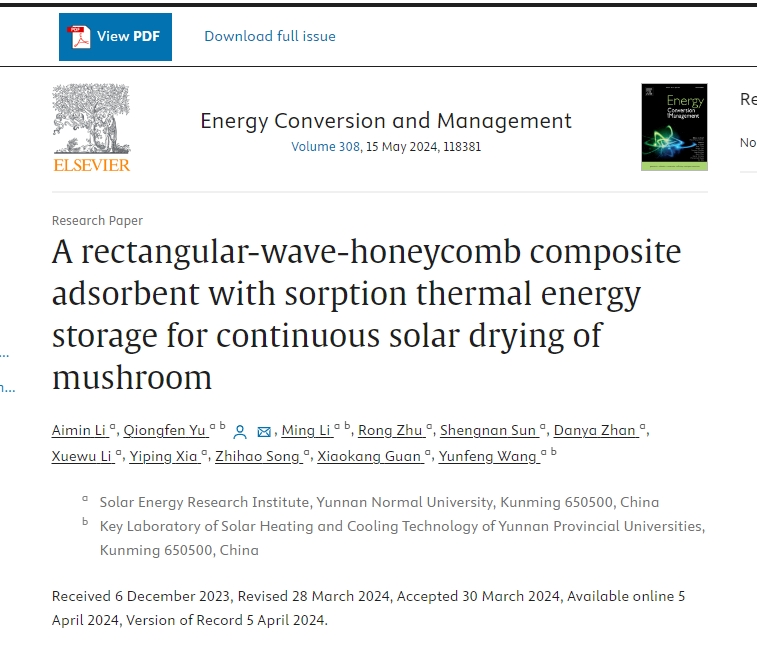2024年4月5日,国际知名能源期刊《Energy Conversion and Management》在线发表了云南师范大学能源与环境科学学院余琼粉教授最新研究成果《A rectangular-wave-honeycomb composite adsorbent with sorption thermal energy storage for continuous solar drying of mushroom》。云南师范大学能源与环境科学学院为第一单位兼通讯作者单位,余琼粉教授为通讯作者。
 Abstract
Abstract
Solar drying is an energy-efficient and environmentally friendly method. However, during periods without sunlight, the lack of energy input to the dryer causes it to cease drying, leading to challenges such as water vapor condensation and product rehydration. To address this, our study proposed a continuous solar dryer (CSD) that integrated conventional solar drying with sorption thermal energy storage (STES), characterized by internal circulation dehumidification at night. The inclusion of adsorption beds within the dryer removed water vapor inside the drying chamber and released sorption heat to supply energy for continuous drying. A series of composite adsorbents was prepared based on an activated carbon fiber (ACF) matrix through impregnation and spraying methods. Among these, ACF-calcium alginate-1/1 (ACF-CA-1/1) was identified as the optimal adsorbent for system-scale preparation and then used for drying mushrooms. Experimental results showed that ACF-CA-1/1 exhibited an adsorption capacity of 0.45 g/g at 20 ℃ and 80 % relative humidity (RH), with an energy storage density of 676.7 J/g. During nighttime drying from 21:00 to 9:00, the adsorption beds facilitated a reduction of 2.64 kg water from 10 kg mushrooms, resulting in a moisture ratio decrease of 29.53 %. The average RH within the drying chamber with STES was 61.37 % and 45.46 % on the first and second nights, respectively. Furthermore, the overall energy efficiency and specific moisture extraction rate of the dryer with STES were 15.50 % and 6.9 × 10−5 kg/kJ, respectively. Those of the dryer without STES were 14.23 % and 6.3 × 10−5 kg/kJ for the same factors, respectively. Notably, solar drying with STES achieved a 30.74 % decrease in RH of drying chamber, an 8-hour reduction in drying time, and a 1.27 % increase in energy efficiency compared to solar drying without STES. Herein, the CSD effectively overcame the rehydration problem of agricultural products at night, offering a promising solution to the intermittent nature of solar drying.

https://www.sciencedirect.com/science/article/pii/S0196890424003224
参考链接:
云师大能环学院余琼粉教授、张莹博士课题组在国际知名能源期刊《Nano Energy》发表最新研究成果
云师大能环学院李明教授课题组在国际知名储能期刊《Energy》发表最新研究成果
云师大 李明、李忠光、高伟和吴鲜思维教授入选全球前2%顶尖科学家榜单
云南师范大学李明教授课题组CEJ:低温氧等离子体对活性碳纤维进行表面改性后的样品结构性质、表面化学及水蒸气吸附的影响
李明教授课题组在Energy Conversion and Management上发表第6篇研究论文
转载本文请联系原作者获取授权,同时请注明本文来自蒋金和科学网博客。
链接地址:https://m.sciencenet.cn/blog-454141-1428642.html?mobile=1
收藏


